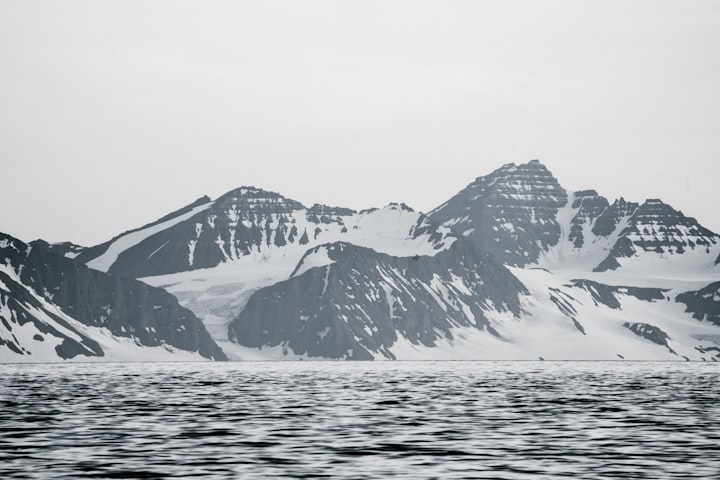The ice of the Arctic gone to the sky?
In recent years, many shocking things have happened in the Arctic.

In recent years, many jaw-dropping things have happened in the Arctic, for example, the temperature in some parts of the Arctic reached 38°C in 2020! The cold Arctic is surprisingly experiencing thunderstorms (the appearance of thunderstorms requires air to produce thermal convection), and the number is on the rise. Some seas are surprisingly almost free of sea ice coverage in summer. Recently, scientists have discovered a strange phenomenon - while the Arctic sea ice is rapidly decreasing, there is more ice over the Arctic! What's going on?
A peculiar phenomenon
In 2018, Japanese researchers conducted scientific research in the Chukchi Sea in the Arctic Circle. The Chukchi Sea is part of the Arctic Ocean, between the Chukchi Peninsula in Russia and Alaska in the United States. Researchers deployed various measurement instruments in this sea, launching cloud particle sensors from a ship with balloons to analyze cloud phases, sampling ambient aerosols on board periodically for chemical analysis, and continuously measuring wave heights and wind speeds at sea.
After several years of testing and data analysis, the researchers found that melting Arctic sea ice in the context of a warming climate led to stronger winds and higher waves in the fall. And the unusual winds and waves carry organic particles from seawater into the atmosphere. When these particles reach a certain height, they become the "seeds" that promote the formation of ice crystals, or condensation nodules. Because of the low Arctic temperatures, these ice crystals freeze the surrounding water droplets, gradually forming ice clouds.
Researchers believe that clouds act like a blanket, reflecting incoming sunlight and reducing the amount of solar radiation reaching Earth, and that ice clouds are brighter and reflect more sunlight. Thus, when sea ice melting peaks in summer, ice clouds will increase and the clouds will thicken, reducing the amount of incident sunlight reaching the surface, which could cool the surface and bring forward the freezing of the sea in autumn. An earlier freeze will result in thicker ice, which may melt less in the following summer and continue into the subsequent winter. If such a process occurs multiple times over several years, it could delay or even prevent the complete melting of sea ice in the Arctic summer.
In a 2018 study, U.S. researchers also found that an increase in ice clouds over the Arctic marginal sea led to increased snowfall. They concluded that when winter comes in the Northern Hemisphere, outbreaks of cold Arctic air cause ice clouds to continue to increase, which likely leads to increased snowfall in the Arctic, resulting in lower local temperatures and increased sea ice area.
So it seems that the increase in Arctic ice clouds may cool the Arctic. Is this the case?
An Uncertain Reality
The cloud cover is like a blanket, which is an appropriate analogy. As a blanket, clouds not only reflect incoming solar radiation but also "intercept" heat from seawater, preventing it from being reflected into space, so that the sun's heat is kept within the atmosphere. The researchers' calculations show that the role of ice clouds in reflecting solar radiation may be much smaller than the role of "locking in" solar radiation dissipation.
Today, in the context of global warming, seawater, which has a greater capacity to absorb solar heat in some areas of the Arctic, is gradually replacing sea ice. The heat absorbed by seawater is released in the fall when Arctic temperatures drop and sea ice begins to form, making local temperatures warmer, which delays the formation of sea ice and thus makes the Arctic winter warmer.

In 2021, NASA is conducting research at an interglacial lake in the northern Baffin Bay between Greenland and Canada. An interglacial lake is an open area of water surrounded by sea ice that forms in the winter as winds blow in a specific wind direction that continuously tears the ice apart. The researchers found that clouds containing large amounts of ice crystals form over the interglacial lake and that these clouds trap heat in the atmosphere and prevent the refreezing of new sea ice. By analyzing the data, the researchers also did find that the clouds over and around the interglacial lake were warmer than in the area covered by sea ice. And, even if the interglacial lakes subsequently refreeze, the clouds and higher heat over them do not disappear until about a week later.
The reason for the different findings in the Chukchi Sea and the Baffin Bay may be related to the condensation nuclei that promote ice crystal formation. In terms of latitudinal position, Baffin Bay is located north of 70°N, while the Chukchi Sea is located south of 70°N. Previous studies have shown that in winter, few particles in the atmosphere over the interglacial lake in the Baffin Bay at 70°N act as cloud condensation nuclei, producing clouds that contain fewer and larger water droplets, which reflect only little incident sunlight into space but prevent heat from escaping from the Earth's surface, thus contributing to warming. In the Chukchi Sea, on the other hand, stronger waves and winds bring more organic particles of the ocean into the sky, which can form many smaller water droplets (ice crystals) and therefore reflect more incoming sunlight, thus cooling the Earth.
This means that the impact of Arctic ice clouds on the Arctic climate is uncertain and needs to be analyzed on a case-by-case basis.
Savior or disaster?
As the Arctic climate continues to deteriorate, scientists have been looking for ways to "save" the Arctic, and the Arctic ice clouds seem to offer a ray of hope. However, until now, the answers to the questions of how Arctic ice clouds form, how they affect the Earth's climate, and whether we can use them to mitigate the Earth's warming have been poorly understood by scientists. So it is too early to say whether the Arctic will keep warming under the "blockade" of ice clouds or cool under the "protection" of ice clouds.
Today, many scientists are aware that Arctic clouds have an important role in Arctic climate change, and more and more research is being conducted with the help of advanced technology. In July 2021, research aircraft from the Max Planck Institute for Chemistry and the University of Mainz in Germany flew to the Arctic, equipped with advanced cloud measurement instruments, and plan to collect data on more than 20 flights to understand Arctic ice clouds and their relationship to climate change.
In the future, based on the results of these studies, scientists will be able to more accurately predict changes in the Arctic climate, and indeed trends in the Earth's climate, and perhaps in these studies, scientists can find ways to reverse Arctic warming.
About the Creator
Many A-Sun
Where your interests lie, that's where your abilities lie.






Comments
There are no comments for this story
Be the first to respond and start the conversation.